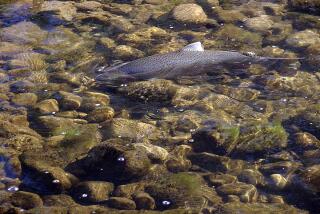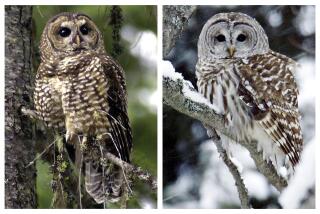Eagle’s Splendor May Have Saved Its Life
- Share via
ALPINE JUNCTION, Wyo. — Perched in haughty and solemn splendor on a snag of a snow-covered cottonwood 60 feet above the Snake River is a bird of prey, intensely alert. It represents a dramatic success story in the distant corridors of Washington’s federal bureaucracy.
The barrel-shaped black body, cream-colored tail and shock of pure white feathers atop its head clearly identify the regal raptor scanning the gray water as a bald eagle, official symbol of the United States since 1782.
The eagle is an apt symbol at a time when Americans tell opinion pollsters that the nation seems to be in decline. After suffering a century of decline that brought the proud species to the brink of extinction, the bald eagle is experiencing a dramatic revival all over the continent. Soon, it may even be removed from the list of endangered species.
“Not all that many years ago,” said biologist Bob Oakleaf, who has been watching the eagle here so intently that a quarter of an inch of snow has caked atop his binoculars, “seeing that eagle up there would have been a once-in-a-lifetime experience for most people. But now we’ve seen--how many was it?--half a dozen or more in the last couple of hours.”
Not only here in Snake River Canyon but also in scores of nesting sites from Mt. McKinley to Miami, bald eagles are being spotted in increasing numbers every year.
“The census for the bald eagle is very encouraging,” said Daniel L. James, a wildlife specialist for the U.S. Fish and Wildlife Service. “It’s reasonable to assume that . . . we will eventually be able to remove that bird from the endangered-species list altogether.”
The apparent salvation of the bald eagle is not the only good news for wildlife managers. Biologists report greatly improved prospects for other well-known animals that have achieved the status of “endangered species.”
The American alligator has been officially listed as recovered, no longer in danger of extinction. The grizzly bear, gray wolf and peregrine falcon are endangered throughout much of their habitat, but population trends are strongly positive for all three.
These facts suggest to government wildlife agencies that the endangered species program has been an unusually successful endeavor in human management of the natural world. But in official Washington, where unanimity of opinion is as rare as the most endangered species, these high-profile successes have sparked a controversy.
Rep. Gerry E. Studds (D-Mass.) has released a General Accounting Office study sharply critical of the management of endangered species. The study said the Fish and Wildlife Service, an arm of the Interior Department, has indulged public tastes at the expense of scientific priorities.
“Instead of focusing expenditures and attention on species close to extinction, Fish and Wildlife has concentrated on highly visible species in relatively less danger,” the report said. It concludes that federal managers are concerned unduly about “species with high public appeal.”
There are 313 domestic animal species and 169 plants on the federal endangered species list. As the General Accounting Office report notes, many face greater risk of extinction than the best-known species. But few rank higher than the bald eagle in terms of “high public appeal.”
A powerful predator known for its keen eyesight, solitary habits and majestic flight, the bald eagle is found only on the North American continent. It is adaptable enough to survive in the icy Alaskan Arctic, the parched Arizona desert and swampy south Florida forests. A growing number nest around Chesapeake Bay.
Shortly after the Revolution, the Continental Congress made this native American the national symbol, rejecting Benjamin Franklin’s suggestion that the wild turkey would be more fitting. Wildlife experts estimate that 50,000 bald eagles were in the continental United States a century ago, before human encroachment began to take its toll.
The first threat came from strychnine and other poisons used by farmers to kill wolves and coyotes, common food for the flying carnivore. The more serious danger came from the widely used pesticide DDT. Passed through the food chain, DDT weakened the shells of eagle eggs, causing thousands of eaglets to hatch too early and die in the nest. As these risks reduced the population, hunting emerged as another threat.
Global Model
By about 1960, only about 800 breeding pairs remained, and the prognosis was bleak. Then the federal government, working with state officials and such private organizations as the Audubon Society, mounted a stepped-up management program that has become a global model for recovery of endangered animals. Today, more than 2,200 pairs breed in the lower 48 states.
Through stiff sentences and far-flung publicity campaigns, officials sharply reduced poaching incidents, and hunters now pose a threat to bald eagles only in Alaska, where the species is abundant.
The government banned DDT in 1972 and cracked down on other poisons. Healthy fledglings were moved to southern and Midwestern states where eagles had nested before the population declined.
The results have been obvious to biologist Oakleaf, who works for the Wyoming Department of Game and Fish and acts as mother hen to several hundred eagles that live in or pass through the spectacular mountain setting of Snake River Canyon each year.
“When I first started this in ‘78,” Oakleaf said, “I would have sworn there wouldn’t be any bald eagles in this canyon a decade later. But now look. We’ve still got some problems . . . (but) this bird is back. I think we can accurately say that the bald eagle has been saved.”
More to Read
Sign up for Essential California
The most important California stories and recommendations in your inbox every morning.
You may occasionally receive promotional content from the Los Angeles Times.










